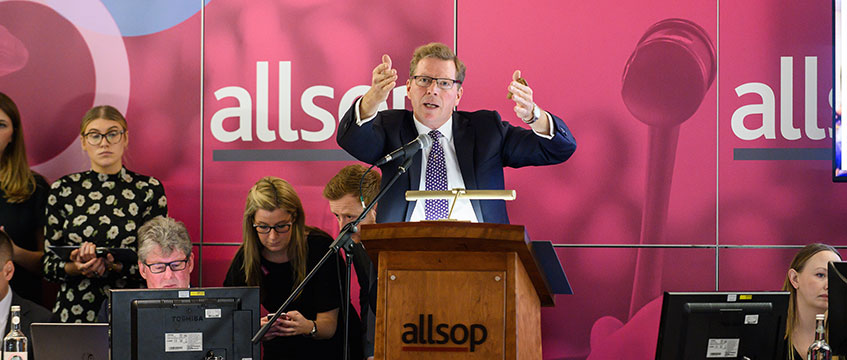Investing Through Auctions: Is the future in or out of the room?
In March last year, the hammer came down on the auctions sector. In the run-up to the first lockdown, attempts to stop the spread of Covid-19 saw businesses close their doors and the nation’s citizens confined to their homes. Within hours, ballroom auctions, attended by thousands of people, transformed from staples of the real estate calendar to super-spreader events, and were then banned altogether.
“The thing I remember is that it all happened very, very quickly,” recalls Allsop gavel-wielder Richard Adamson, speaking on EG’s Investing Through Auctions podcast series. The only solution was to take the entire apparatus online. “It was a big challenge. We had a 300-lot residential catalogue out and 150 lots out for commercial at the time, and it’s a ‘flip the switch’ to go online within seven to 10 days.”
With the clock ticking, Adamson and his team had to get that right, or the auction would have had to be cancelled altogether. “All the parties had that thought in their brain,” he says. “No one said it though.”
In March last year, the hammer came down on the auctions sector. In the run-up to the first lockdown, attempts to stop the spread of Covid-19 saw businesses close their doors and the nation’s citizens confined to their homes. Within hours, ballroom auctions, attended by thousands of people, transformed from staples of the real estate calendar to super-spreader events, and were then banned altogether.
“The thing I remember is that it all happened very, very quickly,” recalls Allsop gavel-wielder Richard Adamson, speaking on EG’s Investing Through Auctions podcast series. The only solution was to take the entire apparatus online. “It was a big challenge. We had a 300-lot residential catalogue out and 150 lots out for commercial at the time, and it’s a ‘flip the switch’ to go online within seven to 10 days.”
With the clock ticking, Adamson and his team had to get that right, or the auction would have had to be cancelled altogether. “All the parties had that thought in their brain,” he says. “No one said it though.”
“Some auctioneers did end up cancelling,” recalls Jesal Patel, principal at Prideview and a familiar face in the auction room.
For a consultant like Patel, whose business is “99% in the room”, the sudden closure of the ballrooms was a shock. But, he says, as long as the contract was in place and there was some way of buying and selling, he was ready to adapt.
The same is true for John Herne, senior trading manager at Mountview Estates, which specialises in buying tenanted properties and selling vacant properties at auction. “I had never bid online,” he says – before last year. Even if he only had a couple of lots in play, Herne would be in the room where it happens.
Learning curve
Suddenly, everything was online. For the rest of us, that meant getting our heads around Microsoft Teams and remembering to turn on the mic. For Adamson’s auctions team, the challenge was far more complex.
“There were a lot of technical difficulties there, in terms of using a platform that could actually support that,” he recalls. Fortunately, Allsop already had a partner from previous forays into online auctions “that we could lean on”.
“So that was reasonably straightforward,” says Adamson. “What was really challenging was educating and relaying the message to the buyer and the seller as to how it would work.”
And if it was hard for Allsop to switch from the ballroom to the chatroom, it was even harder for some clients. “They love being in the room,” Adamson says. “It is their environment, it is their office, and taking that away made it very challenging for them.”
And, again, the clock was ticking. Anyone who loves auctions loves a countdown, but this was pushing everyone out of their comfort zones.
“We had seven days to do that,” says Adamson. “Getting everything in line whereby buyers understood how they would bid, what they had to do and the hoops they had jump through and then understanding what was happening was the biggest challenge.”
I’m all for technology. But there is nothing like sitting in an auction room… meeting people face to face
John Herne, Mountview Estates
Internet innovation
Before the pandemic, online auctions were niche affairs. There were some online specialists, but for the big players, such as Allsop, 95% of auctions took place in “ballrooms”, in much the same way that they had for centuries.
And, of course, those ballroom auctions were actually multi-channel, and had been for years. Bids came in over the phone and via the internet, as well as from the floor. “That level of remote bidding had increased over the years,” says Adamson. At a single auction he could receive up to 600 remote bids. Internet bidding had, slowly but surely, become more popular.
But the sudden switch to being fully online meant that practices had to change. “We were quite big on buying blind,” says Patel. “If something looked cheap on the day, we’d buy it.” He would have done his homework first – reams of notes scribbled in tight handwriting on every lot in the catalogue. “But that’s not something we can do anymore, because I have to be registered on 30 different lots and have about 30 deposits before I even attempt to buy anything.”
Herne agrees, although it hasn’t stopped him buying and selling 200-odd lots over the past year. “There’s lots more rigmarole you have to jump through to be able to make a bid in the first place.”
And that has put some people off – some of the older buyers, the non-digital natives. Conversely, the younger generation seems to be more at home with this style than with the rugged charms of the ballroom.
Despite the constraints of the pandemic, the past 18 months have hardly been a tough time for auctions, especially as the residential market in particular heated up from May. “It’s very hard for me to step back, even now, and say that the online platform made it easier or harder for people to bid,” says Adamson, “because we were just that busy.”
Instead, the past year and a half has seen diversification and innovation. Some, like Auction House London, have fully embraced live-stream auctions. Others prefer the “eBay” style. Herne says there is room for them all. “To be honest, we will go where the properties are.”
Even a die-hard ballroom junkie like Patel has to admit that there are some advantages to online. Now that the restrictions have loosened, he is in Dubai. But that won’t stop him from making a few bids back in the UK.
I miss the room dearly – being an auctioneer was the best and most fun part of my job. I love doing it, and that has been taken away
Richard Adamson, Allsop
Yearning for the ballroom
“I’m all for technology,” says Herne. “But there is nothing like sitting in an auction room… meeting people face to face.”
For now, though, that is not an option. There have been some ballroom auctions in recent weeks. Most have been sparsely attended affairs.
“I prefer being in the room, but I’m not that keen to be rushing back there, to be honest with you,” says Herne. For him, the risks are still too great, with the pandemic still prowling. Which makes him laugh. “I’m a Chelsea fan, and I went to watch football with 40,000 people the other day, but I’m reluctant to sit in an auction room with 700.”
Adamson comments: “If I’m being solely selfish, I miss the room dearly – being an auctioneer was the best and most fun part of my job. I love doing it, and that has been taken away.”
Herne misses the market intelligence, the feeling that the gavel-wielder will be able to cajole or coerce another couple of grand from the audience.
And for Patel it’s the physical, the tactile that he is missing. “I miss my catalogue,” he says. “I had nothing to do on the plane to Dubai.” You still get a catalogue, points out Adamson – it’s on the app.
“But I can’t write my notes,” Patel explains. “I can’t write down my notes on the app and flick through while the properties are selling.”
There is a scribbling sound. Adamson is making notes. In this brave new world of online auctions, things are always changing, always improving. And you can bet that pretty soon on Allsop’s app you’ll be able to make notes.
But one thing won’t change with these three. No matter what else changes about the industry, they will always want to be in the room where it happens.
Expert speakers
Richard Adamson, partner, Allsop
John Herne, head of sales and acquisitions, Mountview Estates
Jesal Patel, principal, Prideview
To send feedback, e-mail piers.wehner@eg.co.uk or tweet @PiersWehner or @EGPropertyNews
In partnership with
Photo © Allsop











